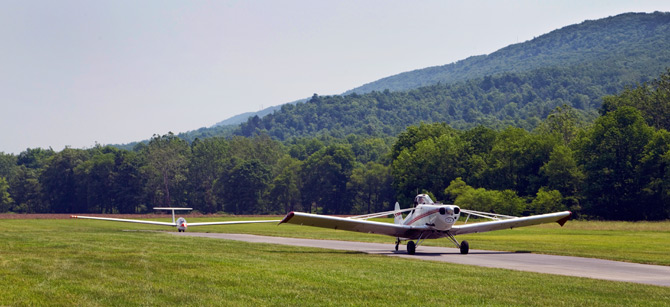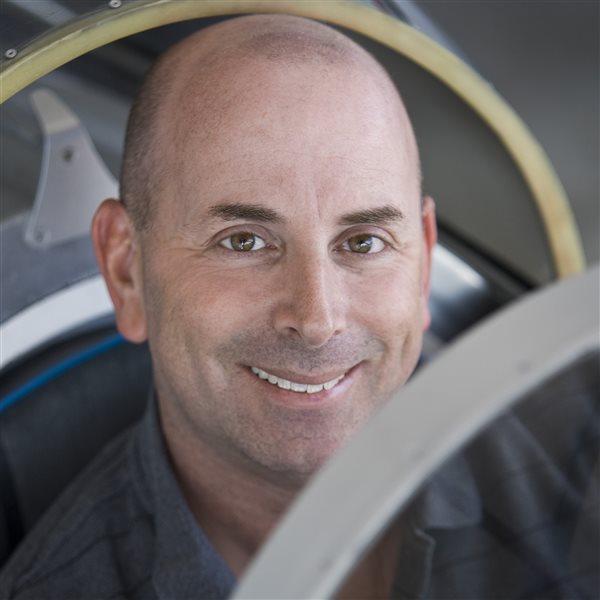Photography by Chris Rose
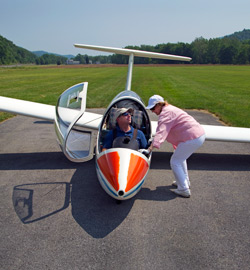
I had anticipated that my first few moments of unpowered flight might be disconcerting. (The engine failures I’ve had in single-engine airplanes over the years sure created some anxious moments.) But separating from the towplane 3,000 feet over the heavily forested ridges of the Allegheny Mountains of central Pennsylvania produces just the opposite effect. Serene and quiet, the two-seat Grob 103 sailplane effortlessly gains altitude as it rides mild thermals on a tranquil, blue-sky afternoon.
“We can fly this entire mountain range on any given day,” said Tom Knauff, a record-setting sailplane pilot and author of Transition to Gliders, a book for powered-airplane pilots seeking new flight challenges. “Sailplane pilots come here from all over the world because the unique geography creates ideal conditions that allow us to fly to Tennessee and back, and stay aloft over 10 hours. Most of the aviation community has no idea what goes on here.”
Knauff, 73, and his wife, Doris Grove, own and operate Ridge Soaring Gliderport, a renowned sailplane operation in the hamlet of Julian, Pennsylvania, an agricultural area just five air miles and one ridge west of State College and bustling Penn State University.
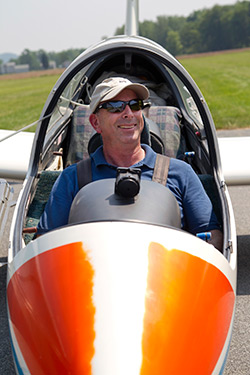
The 20-foot-wide, 1,300-foot-long asphalt runway (79N) on 90 bucolic acres in a narrow northeast-southwest valley has been a launching pad for many national and international record sailplane flights, and plaques honoring those achievements share wall space with posters of exotic cloud formations and photos of thin-winged gliders. Sailplane pilots eagerly await spring and autumn cold fronts that sweep across the Appalachians, spawning steady northwest winds that strike the jagged mountains and create superhighways of continuously rising air.
About 60 glider trailers with license plates from all over the country, and bumper stickers from around the world, are parked in the gravel lot, and hangars contain some of the world’s most exotic and efficient sailplanes. Most range in value from $30,000 to $60,000 although one, a German-built EB 28—a condor-like, self-launching sailplane with a 28-meter wingspan and a glide ratio in excess of 65:1—tops $450,000.
Ridge Soaring Gliderport has a 16-bed bunkhouse for visiting pilots, and the no-frills quarters with shared bathrooms and showers resemble a European hostel. That seems fitting since visitors from Europe, Canada, South America, Australia, and New Zealand are regular guests. Visitors share stories, ride bikes, fish for trout at a nearby stream, and study a giant relief map of the entire Appalachian Mountain chain in the pilot lounge—planning routes for their marathon flights.
Despite their language differences, they all speak of sky conditions and clouds in familiar, enthusiastic terms. Towering cumulus clouds, to them, are “Qs,” and lenticular clouds signifying extreme winds aloft are “lennies.”
Unlike powered flight, which tends to be a solitary affair, glider flying is a team sport that requires a great deal of coordination and cooperation. It takes help to prepare a glider for flight, move it into position, get it off the ground, recover, and store it at the end of the day. “We have to help each other,” Knauff says. “We work on our aircraft together, we fly together, and we rely on each other out of necessity. At the end of the day, we go out to dinner together. The social aspect attracts people to this kind of flying.”
Knauff says it takes most GA pilots eight to 10 dual flights with an instructor to solo a glider. The FARs require about 10 solo flights (and three test-prep flights with an instructor) to take the FAA checkride. (And, no, forced landings in powered airplanes don’t count toward the solo requirement.)
Dogwoods in bloom
The Grob I fly under Knauff’s supervision was built in the early 1980s. Its snug, streamlined tandem cockpit has a familiar altimeter, turn coordinator, and ASI with the same white, yellow, and red markings as powered aircraft, but also a few new ones. The mechanical variometer measures rates of climb and descent like a more sensitive vertical speed indicator; and the yaw string (invented by Wilbur Wright!) is prominently taped to the outside of the canopy at eye level.

“Most powered airplane pilots really have surprisingly little understanding of the forces that make an aircraft fly,” said Knauff, a CFI and frequent towplane pilot. “They also want empirical references for airspeeds and altitudes in the landing pattern. But a glider pilot flying cross-country has to be able to land without reference to an altimeter, and modify patterns based on changing conditions.”
Also, being towed aloft by another aircraft is a new and exhilarating experience for GA pilots making the glider transition.
On the takeoff roll, rudder alone—and plenty of it—keeps the glider directly behind the towplane, and ailerons keep the wings level. Once airborne, Knauff counsels normal, coordinated use of the flight controls. Power pilots tend not to use enough rudder, he says, or they apply it too late. Gliders typically produce much more adverse yaw because their ailerons are at the outboard ends of some very long wings. Also, unlike many GA airplanes, most gliders don’t have mechanical linkages connecting ailerons and rudder.
Sitting so close to the ground accentuates the sensation of speed as the Piper Pawnee, a former ag airplane, pulls us forward and into the air. I try to maintain the proper trail position as the Pawnee climbs and heads for the 800-foot ridgeline on the east edge of the valley.
At times I dip too low and the glider is buffeted by the prop wash and wingtip vortices from the towplane, but light aft stick lifts the glider back into smooth air. I’m fixated on the towplane, and Knauff insists I look left and right to help scan for traffic.
At 3,800 feet msl (3,000 agl), I pull the yellow knob releasing the tow rope and watch it spring forward like a rubber band. I turn right as the towplane turns left, and am entranced by the quietness—even without a headset or earplugs—and comfort of powerless flight. The glider has a sedate roll rate, but its controls are responsive and well balanced, and the visibility is tremendous. At 60 knots, we’re solidly in the airspeed indicator’s green arc, and we’re not even descending. In fact, the variometer shows a slight climb.
I see things I wouldn’t notice from other airplanes. Dogwoods are in bloom on the steep hillsides among the shade of much taller trees. Two bald eagles patrol over a stream that has been recently stocked with hatchery trout.
A series of stalls shows the benign nature of the G103 as it gently buffets and mushes. A crisp stall, apparently, isn’t part of its normal repertoire. I find it nearly impossible to resist the power pilot’s habit of adding right rudder in the climb to compensate for nonexistent P-factor. Negative transfer.
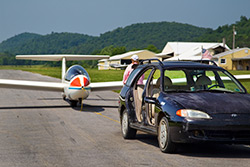
Back in the landing pattern, I’m tempted to set up for a high, close-in pattern just as I would for a power-off approach in a single-engine airplane. Of course, the G103’s glide ratio (36.5:1) is about four times greater than that of most single-engine airplanes. But I’m reluctant to stray far from the runway without an engine. When I just can’t stand going any farther downwind, I start a base turn, pick an aiming point on the blacktop, and deploy the speed brakes in increments.
It quickly becomes obvious that the distance I judged as borderline too far from the runway is actually awfully close for a calm-wind glider pattern. The dive brakes come out and stay out.
“Hold a constant airspeed and use the dive brakes to control the glide-slope,” Knauff advises. My airspeed varies between 55 and 60 knots as I modulate the lift-killing brakes. Frankly, since my left hand (customarily my throttle hand) has been inactive for most of the flight, it feels good to finally give it a job to do.
I fully deploy the dive brakes over the runway threshold and touch down on the main wheel. The dive brakes act as spoilers, and the long-winged craft shows no inclination to fly once it meets the pavement. Ailerons remain effective at a seemingly impossibly slow forward speed, and we come to a stop precisely where we began our flight 30 minutes earlier.
I’ve long envied sailplane pilots and the way they view the sky as a moving, changing river of air with powerful currents that they know how to harness. Hopefully, with a great deal of practice, I’ll come to understand these nuances and use them to fly better, whether I’m in an aircraft with an engine—or not.
Email the author at [email protected].
